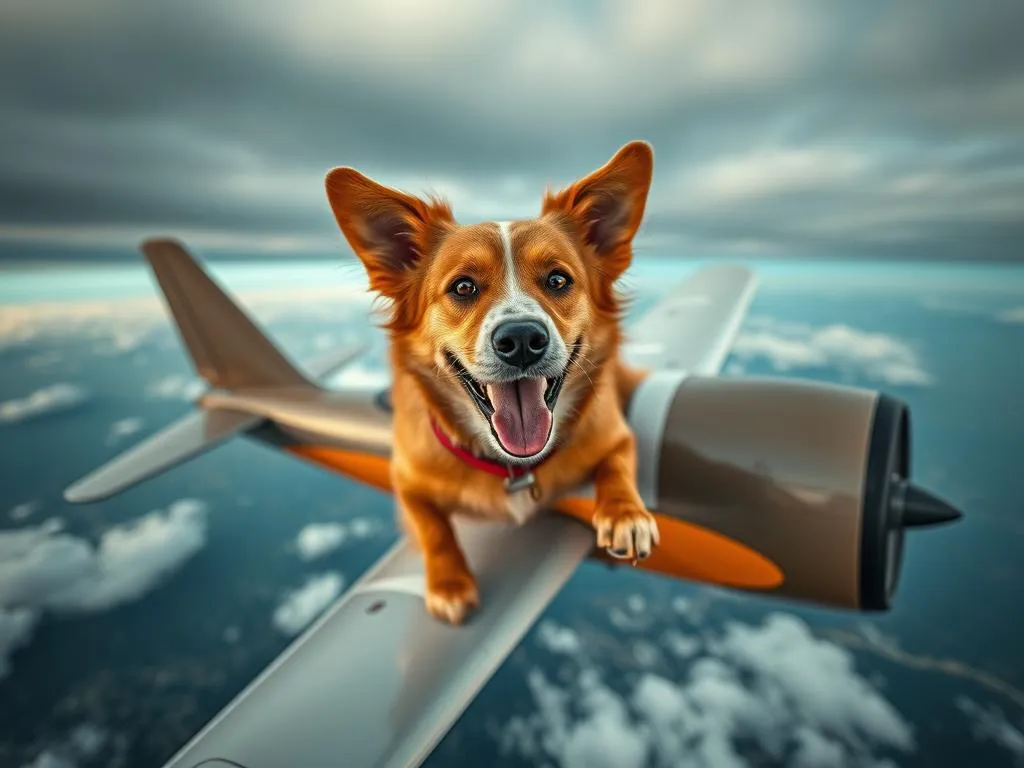
Traveling with pets is becoming increasingly popular, as pet owners seek to include their furry companions in their adventures. With the rise of pet-friendly accommodations and travel services, many are asking the question: can dogs fly on planes? Understanding airline policies is crucial for pet owners who wish to bring their dogs along. This guide will help you navigate the complexities of flying with your dog, ensuring a smooth journey for both you and your furry friend.
Understanding Airline Policies
When it comes to flying with dogs, airline policies can vary significantly. Most airlines have specific regulations regarding pet travel that pet owners need to be aware of to avoid any last-minute surprises.
Overview of Pet Travel Regulations
Airlines differ in their policies regarding pet travel, including the types of animals they allow, the size restrictions for in-cabin pets, and the conditions under which dogs can travel as cargo. Additionally, domestic and international travel can have different requirements, especially regarding health documentation and quarantine regulations.
Types of Travel Options for Dogs
There are generally two travel options for dogs when flying: in-cabin travel and cargo travel.
-
In-cabin travel is often preferred for smaller breeds that fit in a carrier under the seat in front of you. This option allows you to keep your dog close, minimizing stress.
-
Cargo travel is typically designated for larger dogs that cannot fit in a cabin carrier. In this case, dogs are transported in a pressurized and temperature-controlled area of the aircraft.
It’s imperative to check the specific guidelines of the airline you plan to travel with, as each may have different rules and fees associated with pet travel.
Preparing Your Dog for Air Travel
Proper preparation is key to ensuring your dog’s safety and comfort during air travel.
Health and Vaccination Requirements
Before booking your flight, check the health and vaccination requirements for your dog. Most airlines require a health certificate issued by a veterinarian, indicating that your dog is fit for travel. Additionally, certain vaccinations may be mandatory, particularly for international flights. A pre-flight check-up with your vet can help identify any potential health concerns.
Crate Training and Acclimatization
Crate training is essential, especially if your dog will be traveling in cargo. Acclimating your dog to their travel crate can ease anxiety and make them feel more secure. Here are some tips for crate training:
- Introduce the crate gradually: Allow your dog to explore the crate at home, making it a positive space.
- Use treats and toys: Encourage your dog to enter the crate by rewarding them with treats or favorite toys.
- Practice short stays: Start with short periods in the crate and gradually increase the duration to help your dog adjust.
Essential Supplies for Travel
Packing the right supplies is crucial for a successful journey. Be sure to include:
- Food and water: Bring enough food for the duration of your trip and a portable water bowl.
- Comfort items: Familiar toys or a blanket can help soothe your dog during travel.
- Medication: If your dog requires medication, ensure you have enough for the trip, along with instructions on dosage.
Booking Your Flight
Once you are prepared, it’s time to book your flight.
Steps to Book Pet-Friendly Flights
Finding airlines that allow dogs on planes is essential. Many airlines have specific pet policies, so start your search with those that are known for being pet-friendly.
- Reserve a spot: Contact the airline directly to reserve a space for your dog, especially if you plan on traveling in-cabin. Availability can be limited, so it’s best to book early.
Understanding Additional Costs
Be mindful of additional costs associated with flying with dogs.
- Fees: Airlines often charge a fee for in-cabin travel, which can vary significantly. Cargo travel can also incur higher fees, especially for larger breeds.
- Insurance: Consider pet travel insurance, which can provide peace of mind in case of unforeseen circumstances.
Timing and Season Considerations
The timing of your travel is also important.
- Best times to travel: Early mornings or late evenings during cooler months can be more comfortable for your dog.
- Weather implications: Avoid traveling during extreme heat or cold, as this can pose risks for your pet, especially if they are flying as cargo.
At the Airport
Arriving at the airport with your dog can be a bit overwhelming, but with some preparation, the process can go smoothly.
Arriving at the Airport with Your Dog
It’s important to arrive at the airport early to allow enough time for check-in procedures.
- Check-in procedures: Depending on the airline, you might need to check in at a special counter for pets or go through the standard check-in process.
Security Screening Tips
When it comes to security, be prepared to remove your dog from their carrier for screening.
- Calming techniques: Use calming techniques, such as speaking softly or using treats, to help ease your dog’s anxiety.
- Maintain a routine: Keeping to your dog’s routine as much as possible can help minimize stress during travel.
During the Flight
Whether your dog is flying in-cabin or as cargo, there are considerations to keep in mind.
In-cabin Travel Considerations
If your dog is flying with you in the cabin, there are several factors to consider.
-
Seat selection: Choose a seat that provides enough space for you and your pet, preferably near the front of the aircraft for quicker boarding and deplaning.
-
Interacting with staff and passengers: Be courteous to fellow passengers and flight attendants. Ensure your dog remains calm and quiet during the flight.
Cargo Travel Considerations
If your dog is traveling as cargo, it’s vital to understand what to expect.
-
Safety and comfort: Ensure your dog’s crate is well-ventilated, secure, and comfortable. Include familiar items to help them feel at ease.
-
Monitoring your dog: While you won’t be able to see your dog during the flight, trust that airlines have protocols in place for their safety and well-being.
After the Flight
Once you arrive at your destination, it’s time to pick up your furry friend and help them adjust.
Picking Up Your Dog
The process of picking up your dog can differ based on how they traveled.
- Arrival process: For in-cabin pets, you’ll simply exit the plane with your dog. For cargo pets, you may need to go to a designated area to retrieve them.
Signs of Stress or Health Issues Post-flight
After the flight, pay close attention to your dog’s behavior and health.
- What to look for: Signs of stress can include excessive panting, whining, or lethargy. If you notice anything unusual, consult a veterinarian promptly.
Reacclimating Your Dog to Their Environment
Transitioning back to normal life can take some time for your dog.
- Tips for easing back: Maintain a consistent routine, provide plenty of love and attention, and allow for gradual exploration of the new environment.
Alternatives to Air Travel
If flying with your dog seems daunting, consider other modes of transportation.
Other Modes of Transportation for Dogs
Traveling by car or train can offer a more relaxed experience.
-
Road trips: Many dogs enjoy car rides, allowing for more frequent stops and flexibility.
-
Train travel: Some train services are pet-friendly, providing a unique travel experience without the stress of flying.
Pros and Cons of Traveling by Car vs. Flying
Each mode of transportation has its advantages and disadvantages.
-
Car travel: Offers more control over travel conditions but can be time-consuming.
-
Flying: Faster but can be stressful for pets, especially with airport procedures.
Recommendations for Dog-Friendly Travel Destinations
When planning your travels, look for dog-friendly destinations where your furry friend can enjoy the adventure alongside you.
Conclusion
Traveling with your dog can be a rewarding experience when planned correctly. From understanding airline policies to preparing your dog for air travel and managing their needs during the trip, the key to successful pet travel is preparation. Always adhere to pet travel regulations to ensure a safe and enjoyable journey for both you and your beloved pet.
FAQs
Can all dog breeds fly on planes?
Not all breeds are allowed to fly, particularly brachycephalic breeds (like bulldogs and pugs) due to respiratory issues. Always check your airline’s policy regarding restricted breeds.
What should I do if my dog is anxious during the flight?
Consider using calming aids such as anxiety wraps, calming treats, or consult your veterinarian for medication options.
Are there any restrictions for flying with puppies?
Most airlines require puppies to be at least eight weeks old and fully weaned before they can travel. Check with your airline for specific rules.
How do I choose the right crate for my dog?
Select a crate that is well-ventilated, secure, and large enough for your dog to stand, turn around, and lie down comfortably.
With proper preparation and understanding of the necessary guidelines, flying with your dog can be a fun and fulfilling experience.









